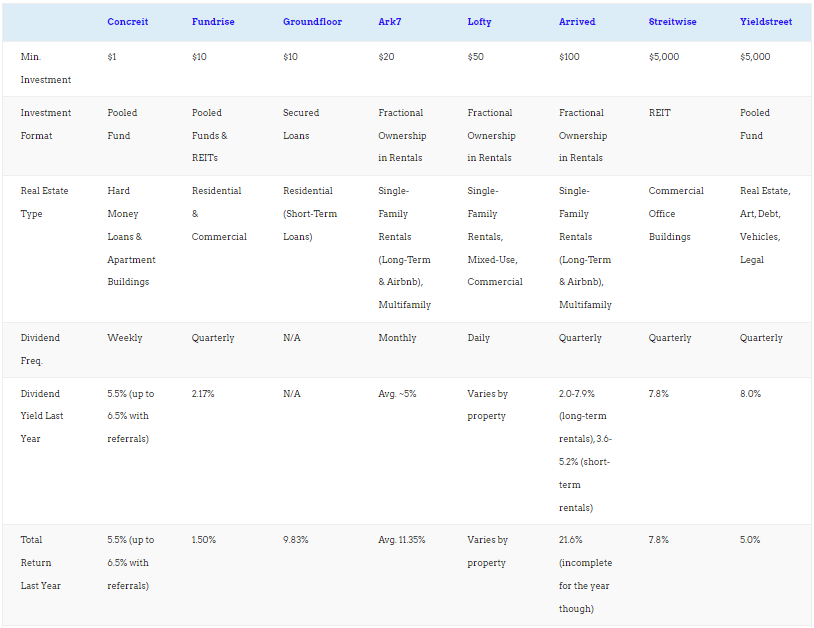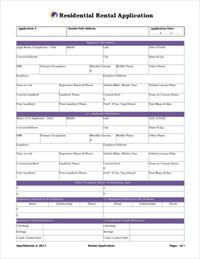The Big Picture On Investing in Real Estate Syndications
-
- Real estate syndications are passive investments in which you buy fractional ownership in an apartment complex or other large property (or properties in a fund).
- As a financial investor, you don’t have to do any labor and don’t make management decisions.
- Most real estate syndications aim for high returns (15-30%+) and come with full real estate tax benefits.
Disclaimer
The information provided on this website is for general informational purposes only and should not be construed as legal, financial, or investment advice.
Always consult a licensed real estate consultant and/or financial advisor about your investment decisions.
Real estate investing involves risks; past performance does not indicate future results. We make no representations or warranties about the accuracy or reliability of the information provided.
Our articles may have affiliate links. If you click on an affiliate link, the affiliate may compensate our website at no cost to you. You can view our Privacy Policy here for more information.

If you’ve never heard the term “real estate syndication,” you’re not alone. Most people don’t know, and even fewer know what a real estate syndication is or how it works.
Historically, only the wealthy could access private equity investments like these. That has changed in recent years, and the middle classes are increasingly able to access real estate syndications.
But what is a real estate syndication? How are real estate syndications structured? How well do they pay, and what are the risks? And do you really need at least $50,000 to invest in them?
Strap in! Real estate syndications have changed how I think about real estate investing, supercharging my returns while minimizing my labor.
The Quick Answer in <2 Minutes:
What Is a Real Estate Syndication?
A real estate syndication is a private equity real estate investment in which the lead investor raises money from private investors to help fund the purchase of a large commercial property. Examples of properties could include multifamily apartment complexes, self-storage facilities, mobile home parks, retail properties, office buildings, agricultural land, industrial parks, or oil and gas fields.
Imagine you find an apartment building for sale at a deep discount and want to buy it. But even with an investment property loan covering 70% of the purchase price, you still can’t afford the 30% down payment. So, you raise some of the remaining money from friends, family members, neighbors, and your aunt’s second cousin once removed.
In exchange for a portion of the ownership, of course.
Granted, most people don’t have enough rich family members to cover huge commercial real estate deals. So, as they scale, they start raising money from people they don’t know.
People like you and me.
Who’s Involved In Real Estate Syndications?
You need to know about a few key players in real estate syndications.
First, the lead investor on a real estate syndication deal is known as the sponsor, or alternatively the general partner (GP), operator, or syndicator. While lawyers quibble that there are technical differences between those labels, we’ll use them interchangeably. Sponsors are professional real estate investors, hopefully with a long track record of success. Their duties include finding the deal, raising all the money needed to close it, overseeing all renovations and repairs, overseeing the property management, distributing cash flow, and eventually selling the property.
If you see the term co-sponsor refers to someone who is helping to raise money or support the deal in another way but who isn’t the lead sponsor on the deal. You might alternately see them referred to as co-GPs.
General partners raise some of the capital to buy the property from financial investors like us. We invest our cash in the deal as “limited partners” or LPs, becoming fractional property owners.
If you invest in a fund with multiple properties, the lead sponsor might instead refer to themselves as the fund manager.
You know the other players involved: lenders, property managers, and contractors. But if you have any other questions about terminology, check out our glossary of terms in real estate investing.
Support Roles in Real Estate Syndications
Although sponsors and limited partners are the main players in syndications, there are professional roles that help ensure the success of each investment.
|
Role |
Typical Qualifications |
Primary Responsibilities |
|
Asset Manager |
Real estate management experience, financial analysis background |
Oversees property performance, implements business plan, reports to investors |
|
Investor Relations Manager |
Communications background, customer service experience |
Handles LP communications, distributes reports, manages capital calls |
|
Legal Counsel |
Real estate law expertise, securities law knowledge |
Structures deal, creates operating agreements, ensures SEC compliance |
|
Due Diligence Team |
Market analysis expertise, underwriting experience |
Verifies property financials, inspects property condition, analyzes market |
|
Construction Manager |
Construction background, project management experience |
Oversees renovations, manages contractors, controls budgets |
Real Estate Syndication Structure
In a real estate syndication, the sponsor/general partner finds the deal and oversees the purchase, repairs, management, and, eventually, the refinancing or sale of the property. They take out an investment property loan to cover some of it, put some of their own cash in the deal, and raise the rest from limited partners.
The GP usually includes some extra fees and returns to compensate them for their trouble. For example, they might collect an acquisition fee of 1-3% of the purchase price or a disposition fee when they sell the property.
They also receive a prespecified portion of the profits upon sale, known as the promotion. Again, this is their reward for doing all the labor to oversee the deal.
Some sponsors structure the returns so that the more the property earns, the greater their cut. For example, the limited partners (the passive investors like you and me) might get an 8% “preferred return” on all revenue. That means we get paid the first 8% in returns before the GP gets a dime. Above that 8% threshold, there could be a 70/30 split on returns up to 20%, with 70% of returns coming to LPs and 30% going to the GP. With over 20% annual returns, the split might drop to 50/50.
In this example, imagine the property earns a total annualized return of 25%. To compensate the limited partners for their work, the sponsor would earn a greater share of that than the limited partners. Limited partners would earn an annualized return of 18.9%: the 8% preferred return plus 70% of the next 12% plus 50% of the next 5%.
This arrangement is called a waterfall, as the profit share changes once the returns hit certain thresholds.
As for the legal structure, the sponsor creates a legal entity such as an LLC, and all partners are listed as partial owners.
Eligibility Criteria for Investing In Real Estate Syndications
Some real estate syndications only allow wealthy accredited investors to participate in them. To qualify as an accredited investor, you must have a net worth over $1 million (not including equity in your primary residence), or have earned at least $200,000 for each of the last two years ($300,000 for married couples).
Why? Why exclude everyday investors?
Because the government says so, the Securities and Exchange Commission (SEC) regulates these investments, making it harder for syndicators to accept middle-class investors. But they do leave the door open.
Sponsors can raise money from up to 35 non-accredited investors for a syndication deal if they classify it as a 506(b) investment. However, they must meet certain conditions and endure some restrictions.
First, these investors must know about this field and count as “sophisticated investors.” Second, these investors must have a pre-existing relationship with the sponsor. The idea is to allow the sponsor’s friends and family to invest with them, but not the general public. In fact, sponsors can’t advertise 506(b) investments to the public at all.
A sponsor must file the investment as a 506(c) security if they want to advertise to the public. This restricts them from accepting money from accredited investors and frees them from the restrictions on 506(b) investments.
How to Invest In Real Estate Syndication Deals
The mechanics of investing in syndication are simple: You wire the money and sign a legal agreement. This document, called a private placement memorandum (PPM), outlines the terms of the investment.
Once you’ve invested your money, sit back, relax, and let the passive income from distributions and profits roll into your bank account.
But slow down a second here. How do you find reputable sponsors? How do you vet real estate syndication deals?
The easy answer is that you join a real estate investment club like ours. We network with sponsors for you and then go in front of the club to explain their latest deals. Then, our Co-Investing Club discusses and vets the deal together and decides whether to proceed.
If you want to invest independently, you must network with sponsors, demand to see their track record and evaluate their business model. You must vet each deal before investing in it.
Pros and Cons of Investing in Syndicated Real Estate Investments
Should you invest in real estate syndications?
It depends on how you feel about the following pros and cons.
Pros of Real Estate Syndications
Investors like real estate syndications for the following reasons:
-
- High potential returns: Real estate syndications aim for high returns, typically 15-30% annualized returns.
- Passive income: Part of those returns comes from cash flow. While syndications pay distributions, most do, commonly in the range of 4-8% per year.
- Appreciation and profits upon sale: The other part of the returns comes from profits when the property sells. In fact, the bulk of the targeted 15-30% annualized returns comes from these profits at the very end.
- Potential for infinite returns: If the sponsor refinances the property rather than selling, they can return your initial investment back to you — even as you keep your ownership interest in the property. You keep earning distributions and appreciation, even though you got your money back and can reinvest it in another asset.
- Tax advantages: Passive investors in real estate syndications get all the same tax benefits as landlords and active investors. All the same real estate tax deductions apply, plus you get accelerated depreciation. The upside: you often show a loss on your tax return, even though you collected distributions. (More on tax benefits below.)
- Simplified accounting: Rental properties come with accounting and bookkeeping headaches. You have to track all income and expenses, all properly labeled, and file a Schedule E tax statement for all your properties. Get it wrong, and the IRS comes knocking. With real estate syndications, the sponsor sends you a K1 with a bottom line number to enter on your tax return.
- Diversification/low correlation to stocks: Real estate syndications share almost no correlation with the stock market. That means they provide true diversification from your stock investments.
- Passive investment: You don’t have to become a landlord, don’t have to line up financing or find deals, and don’t have to hassle with contractors, tenants or property managers. Syndications are a purely passive investment in real estate.
Downsides of Real Estate Syndications
People often balk when I tell them the returns real estate syndications pay. They either don’t believe it or assume the risk is high.
However, syndications must pay high returns if they want to attract private investors despite the inconveniences of investing in them.
-
- No liquidity: Once you invest money in a real estate syndication, it stays locked up until the sponsor refinances or sells the property. You can’t sell or withdraw funds early.
- Medium/long-term investment: Most real estate syndications last 2-7 years. That’s not a trivial amount of time to tie up your money without access.
- High minimum investment: If you invest by yourself rather than as a member of an investment club like ours, you have to invest the full minimum. Typical minimum investments range from $50,000 to $100,000.
- Potentially high investment in a single asset: Solo investors not investing through a club commit huge amounts of money to a single asset. That makes it hard to diversify within your real estate portfolio and spread money among many investments.
- Some syndications only allow accredited investors: As outlined above, some real estate syndications only permit wealthy accredited investors to participate.
- Delay before distributions start: Some syndications don’t start paying passive income distributions for a year or two. This often depends on the amount of “value add” required by the property—the more renovations or updates required, the longer it takes for the property to start cash flowing well.
 Understanding Returns on Real Estate Syndications
Understanding Returns on Real Estate Syndications
I’ve seen real estate syndications pay annual returns of over 100%.
Of course, that’s not typical. You’re often looking at 15-30% annual returns, including cash-on-cash returns (yield) and capital gains when the property sells.
This raises another point: sponsors use several measurements for returns on real estate syndications.
The simplest is equity multiple: what the property sells for as a multiple of what they bought it for. For example, if you invest in a syndication that buys a property for $1 million and you sell it five years later for $2 million, that’s an equity multiple of 2.0. If it sold for 80% higher than what you bought it for — $1.8 million — that would be an equity multiple of 1.8.
The average annual return is another simple way to measure real estate syndication returns. It’s just the total return on the project after it sells, divided by the years you owned the property. In the example above, selling the property for $2 million after five years would mean a 20% average annual return: a 100% return on the initial investment divided by five years of holding it.
The reality looks a little more complicated, as most syndications pay cash flow distributions. For example, say that the same project paid 7% per year in distributions while you owned it before selling for twice the initial investment five years later. In that case, the average annual return would be 27%.
The most complicated and accurate measure of real estate syndication returns is the internal rate of return (IRR). It sounds complicated, and the calculation is complicated, but the concept is simple enough. It calculates the annualized return you earned, taking compound interest into account. Because investments compound over time, but most real estate syndications pay out most of their returns at the very end, you don’t get to reinvest most of those returns along the way. The IRR metric calculates your annual return if you had received the return each year and reinvested it at the same rate.
If you like the idea of 15-30% returns on passive real estate investments but want to invest with $5,000 instead of $50,000, check out our Co-Investing Club. Our “tribe” proposes a monthly real estate syndication deal, and we all combine funds so we can each invest with less.
Read more about ROI on real estate for a deeper breakdown of syndication returns.
Real Estate Syndication Risks
When people first learn about real estate syndications, their eyes often see dollar signs at the enormous returns most syndication projects generate.
But high returns never come without risk. Large commercial real estate deals can and do go wrong, leaving investors with low returns or even losses.
The renovations could cost double the estimated amount or take twice as long. Occupancy rates could come in lower than expected. The local housing inspectors could refuse to issue permits until they are paid hefty bribes (you can laugh, but I’ve seen that happen).
For that matter, the sponsor could take your money and run off to Guatemala.
More mundanely, the local market could just see a housing market correction, or a recession could strike. While rental properties are more recession-proof than most investments, they aren’t immune to economic downturns. Rents don’t typically drop, but vacancy rates and eviction filings rise in recessions.
So, how do you mitigate these risks as you evaluate investment opportunities?
Minimizing Risks of Real Estate Syndication Investing
First, vet the sponsor carefully. How long have they been investing in this real estate niche? How many real estate property deals have they done in the past? What’s their track record and past returns on those real estate projects? Have they ever lost investors’ money?
Next, do your due diligence on the real estate deal itself. Is the local real estate market seeing population growth? Economic and job market growth? What’s the local unemployment rate? What property class is it (A, B, C, etc.)? How conservative is the underwriting of the deal? At what occupancy rate would the deal break even? How much property leverage is the sponsor borrowing?
Keep asking questions until you have a firm yes or no on the deal. If you’re still unsure after asking questions, opt out of the deal.
Gauging the risk of a real estate syndication is an entire art and science. We teach a class on How to Spot Low-Risk Syndication Investments, all about finding those asymmetric returns.
Real Estate Syndication vs. REITs
What’s the difference between a real estate syndication and a REIT (real estate investment trust)?
Real estate syndications are private equity investments that are not traded on public stock exchanges and are not necessarily available to the general public. Many are only open to accredited investors with a net worth of over $1 million or high incomes.
There’s no secondary market for selling your shares in real estate syndications. That means no liquidity: once you buy in, your money remains locked in the deal until the GP either sells the property or refinances it to return capital to you and the other investors.
In other words, real estate syndications should be approached as long-term investments. Once on the ride, you stay on until it comes to a full stop.
Real estate syndications also come with much higher minimum investments than public REITs. Most syndications require a minimum investment between $25,000 and $100,000 — hardly chump change. In contrast, you can buy shares in publicly traded REITs for the price of a single share, often $10–$100.
Suppose those all sound like downsides (and they are), real estate syndications have several huge upsides. To begin with, REITs have too much correlation with the broader stock market. When the stock market falls, so do REITs in most cases, even if real estate markets remain strong.
Real estate syndications often pay dramatically higher returns. Being available to the public, public REITs earn returns based on whatever Joe Six Pack is willing to accept. If you’re only willing to invest at a yield of 10%, but he’s willing to invest for a 7% yield, he’ll outbid you on the stock.
However, real estate syndications are private investments that are not easily accessible to every Jimmy and Joe. That exclusivity is precisely what drives up the returns.
See the other pros of real estate syndications outlined above. Personally, I avoid REITs and invest my own money in real estate syndications.
 Real Estate Syndications vs. Crowdfunding
Real Estate Syndications vs. Crowdfunding
While real estate crowdfunding investments are more common with real estate syndications than public REITs, they’re still available. Some only allow accredited investors to participate, others allow anyone to invest, but they’re all publicly advertised.
Most real estate crowdfunding platforms allow investors to sell early, even if they charge a penalty for it. You can pull your money out early if you want to take a hit. That option doesn’t exist at all for most real estate syndications.
Like real estate crowdfunding investments, some syndications allow equity investments, while others offer debt investments. Some offer both. Debt investments pay more consistently and have high cash flow, while equity investments offer more upside potential when the property sells.
If you’re new to passive real estate investing, start with real estate crowdfunding. You can find public reviews of crowdfunding platforms more easily than private real estate syndicators, making them easier to vet. Plus, you can usually invest at any time rather than waiting for individual property deals to come along.
Tax Benefits of Real Estate Syndications
Syndications come with significant tax advantages, even for passive investors.
The syndication legal entity doesn’t pay any taxes itself—all profits and losses pass through to individual investors, preventing double taxation.
It also means that all investors, including limited partners, can take advantage of all property tax deductions. From loan interest to closing costs, repairs to property management fees, and beyond, these deductions reduce the taxable income from syndications.
Most notably of all, those deductions include paper losses from depreciation. Even as investors collect distributions and cash flow, they typically show paper losses on their tax returns in the first few years due to accelerated depreciation. You can use those paper losses to offset passive income from other sources, but unlike how rental income is taxed, you can’t use losses from syndications to offset up to $25,000 in active income.
You can carry the paper losses forward if you don’t have other passive income streams to offset this year. They’ll come in handy when the property sells and you get a fat paycheck (and tax bill).
You can also use 1031 exchanges with real estate syndications, but it’s tricky. Suppose you want to convert 1031 Exchange funds from another real estate sale into a syndication. In that case, you have to convince the sponsor to structure your investment as “Tenants in Common” rather than a typical LP investment. Most sponsors are only willing to do that for high rollers investing $500,000 or $1 million in their deal.
Alternatively, entire real estate syndications can 1031 Exchange when they sell a property. But it requires all (or at least most) LPs to be on board, so it’s usually designed this way from the start.
Step-by-Step Real Estate Syndication Investment Process
Real estate syndication might sound complex, but the actual process follows a straightforward path. Here’s exactly how to go from interested investor to fractional property owner:
- You’ll receive an investment summary outlining the deal specifics, projected returns, and business plan. Review this thoroughly—it’s your blueprint for understanding the opportunity.
- Once you’re interested, you’ll submit an “indication of interest” form. This isn’t binding, but it tells the sponsor you’re seriously considering investing and reserves your spot while you complete due diligence.
- Next comes the formal investment phase. You’ll receive subscription documents, including the Private Placement Memorandum (PPM), which outlines all legal terms and risks. You’ll also get operating agreements and formal investment documents.
- After reviewing and signing these documents, you’ll receive wire instructions to transfer your investment funds to the deal’s escrow account. Once the sponsor confirms receipt, you’re officially a limited partner in the syndication.
The process typically takes 1-2 weeks from receiving the investment summary to funding. Most sponsors handle everything electronically now, meaning it’ll be much more streamlined and paperless.
Understanding Fee Structures
Real estate syndication fees can seem mysterious, but they’re actually quite standardized across the industry.
The acquisition fee compensates the sponsor for finding and securing the deal. It typically runs 1-3% of the purchase price. Think of it as a finder’s fee for sourcing a profitable opportunity.
Asset management fees cover the ongoing work of overseeing the property and executing the business plan. These usually range from 1-2% annually of invested capital. This pays for the sponsor’s time and expertise in managing your investment.
When the property sells, expect a disposition fee of 1-2% of the sale price. This covers the work involved in preparing and executing the exit strategy.
Some sponsors also charge construction management fees if major renovations are planned, typically 5-10% of the construction budget. This compensates them for overseeing contractors and managing the improvement process.
These fees are factored into the projected returns you see in the investment summary. While they impact your bottom line, they align the sponsor’s interests with yours—they only really profit when they execute the business plan successfully.
FAQs About Real Estate Syndications
Still, have questions about these group real estate investments? These answers might help.
What are the three phases of real estate syndication?
General partners for real estate syndications refer to three phases of a deal: the origination, operation, and liquidation phases. The origination phase involves finding a good deal, raising money to buy it, and closing on the property. As the name suggests, the operation phase involves managing the property, improving it, and raising revenues. The liquidation phase involves selling the property for a profit.
How do real estate syndicates make money?
Real estate syndication deals make money by adding value to a property and raising the rents. Not only does that improve the cash flow while the sponsor owns the property, but it also increases the property’s value, as commercial real estate is priced based on net operating income and cap rates. The sponsor adds value by increasing rents and revenues, adding profits upon sale.
What are the different types of real estate syndications?
Real estate syndications fall into many buckets. To begin with, they could be a single property, a fixed portfolio of a few properties, or an open-ended fund that hasn’t yet bought all the properties. Syndications could include different types of commercial properties, including multifamily apartment buildings, self-storage facilities, mobile home parks, retail or restaurant properties, industrial properties, office buildings, outdoor recreation such as campgrounds and RV parks, natural resources such as oil and gas, or agricultural properties such as farms or vineyards.
How do investors decide which real estate syndications to get involved in?
I mean… how do investors decide which stocks to buy? You invest based on your goals, risk tolerance, and investment hypothesis.
Look for deals in stable or growing markets with investor-friendly local laws. Look for a fair profit split between the GP and LPs. Most of all, look for GPs with a strong and long track record of success.
I personally invest for diversification: I want to do deals in many cities and states with different sponsors and different property types. I don’t know what tomorrow will bring, but I know that with eggs in enough different baskets, the law of averages will help protect my returns.
How do you determine the potential returns of a syndication?
The sponsor provides you with projected returns, but you are responsible for verifying how realistic and conservative they are. Broadly speaking, returns depend on two main factors: how well the sponsor can raise revenues and the exit cap rate.
Sponsors don’t have much control over the exit cap rate, so look for a “sensitivity analysis” showing how the deal would perform at different exit cap rates. The market might move, with buyers paying less for the same income levels.
Sponsors have more control over raising revenues. What’s their plan for improving the property to command higher rents? What’s their plan to improve property management and occupancy rates? Make sure you feel comfortable with their projections.
Final Thoughts
Real estate investors can make money in countless ways, from long-term rentals to short-term, flipping houses to wholesaling real estate, mobile home parks to self-storage to office buildings. That says nothing about passive real estate investing options like REITs, private notes, and real estate crowdfunding.
However, few real estate assets blend the high return on investment, positive cash flow, tax breaks, and hands-off nature of real estate syndication deals.
As you consider expanding your investment portfolio to include real estate syndications, keep your long-term investment goals and financial needs in mind. You may not get your money back for five years or longer — a deal breaker for many investors, regardless of the returns.♦
How do you see syndications fitting into your real estate portfolio? What questions do you have about them?





























Real estate syndications are a great source of passive income. Invested in my first one last year, exceeded my expectations so far.
Glad to hear you’ve had positive experiences investing in real estate syndications Kevin!
I’m considering adding syndications in my portfolio but I need some guidance. Do you have any recommendations?
Hi Stephanie, we’re actually in the process of re-releasing our FIRE from Real Estate course, and one of the benefits we’ll be offering for our students is a list of vetted, reputable real estate syndication sponsors. We’ll even be coordinating joint venture investments in some, so our students can pool resources and invest with less capital.
Count me in! Please reach me through my email when it’s out.
The minimum investment between $25,000 and $100,000 in syndications gave me a second thought. I would rather go with crowdfunding.
I hear you Leonard! We’ll soon be letting our students invest with $5-10K, but that’s still a lot more than the $10 that some real estate crowdfunding companies allow.
$5-10K is still a little bit high but I can take that. A lot better than $50-100K.
Real estate syndications are a go-to for experienced investors. It’s almost like a trade secret in the industry.
Agreed Oscar!
I’ve been curious to real estate syndication for many months. The time has come for me to join the club!
Glad to hear it Aliza!
Love the idea of splitting the minimum investment with other investors. I’m big on diversification, so the less I can invest in each syndication deal, the more I can spread my money among many different deals, cities, etc.
I agree wholeheartedly Patrick!
Been something that I keep hearing about. Going to look into your investment club and see if it’s a good fit.
Keep us posted about your questions Jenn!
This is by far the most expansive article I have read on so many different areas of PE Real Estate Syndication from: sponsor underwriting, equity waterfalls, diversification, taxes, pros/cons, passive-losses on tax returns, evaluating syndication returns (IRR vs Equity MOIC) etc.. this article has it all.
It also seemed easy to understand to individuals new to RE syndications.
Thanks Aidan, glad to hear it was helpful!